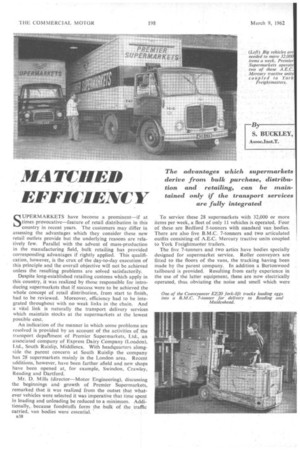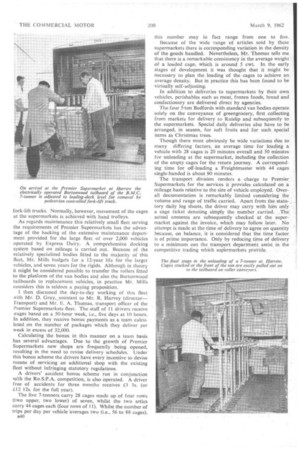MATCHED EFFICIENCY
Page 72

Page 73

Page 74

If you've noticed an error in this article please click here to report it so we can fix it.
The advantages which supermarkets derive from bulk purchase, distribution and retailing, can be maintained only if the transport services are fully integrated [
By
S. BUCKLEY,
Assoe.Inst.T.
SUPERMARKETS have become a prominent—if at times provocative—feature of retail distribution in this country in recent years. The customers may differ in assessing the advantages which they consider these new retail outlets provide but the underlying reasons are relatively few. Parallel with the advent of mass-production in the manufacturing field, bulk retailing has provided corresponding advantages if rightly applied. This qualification, however, is the crux of the day-to-day execution of this principle and the overall objective will not be achieved unless the resulting problems are solved satisfactorily.
Despite long-established retailing customs which apply in this country, it was realized by those responsible for introducing supermarkets that if success were to be achieved the whole concept of retail distribution, from start to finish, had to be reviewed. Moreover, efficiency had to be integrated throughout with no weak links in the chain. And a vital link is naturally the transport delivery services which maintain stocks at the supermarkets at the lowest possible cost.
An indication of the manner in which some problems are resolved is provided by an account of the activities of the transport depanment of Premier Supermarkets, Ltd., an associated company of Express Dairy Company (London), Ltd., South Ruislip, Middlesex. With headquarters alongside the parent concern at South Ruislip the company has 28 supermarkets mainly in the London area. Recent additions, however, have been farther afield and new shops have been opened at, for example, Swindon, Crawley, Reading and Dartford.
Mr. D. Mills (director—Motor Engineering), discussing the beginnings and growth of Premier Supermarkets, remarked that it was realized from the outset that whatever vehicles were selected it was imperative that time spent in loading and unloading be reduced to a minimum. Additionally, because foodstuffs form the bulk of the traffic carried, van bodies were essential. ' To service these 28 supermarkets with 32,000 or more items per week, a fleet of only 11 vehicles is operated. Four of these are Bedford 5-tonners with standard van bodies. There are also five B.M.C. 7-tonners and two articulated outfits consisting of A.E.C. Mercury tractive units coupled to York Freightmaster trailers.
The five 7-tonners and two artics have bodies specially designed for supermarket service. Roller conveyors are fitted to the floors of the vans, the tracking having been made by the parent company. In addition a Burtonwood tailboard is provided. Resulting from early experience in the use of the latter equipment, these are now electrically operated, thus obviating the noise and smell which were
previously inevitable when the oil engine of the vehicle was idling to provide power for the original hydraulic tailboard. The design of the electrically operated version was the result of close co-operation between Burtortwood and Premier Supermarkets, coupled with the added experience derived by Express Dairy in the operation of over 2,000 electric vehicles.
To facilitate speedy and economic movement of a vast range and quantity of items both in the central warehouse at South Ruislip and during subsequent distribution to the 28 supermarkets, handling methods have been largely mechanized. A standard cage is used throughout the system and, incidentally, is interchangeable with that used by the parent Express Dairy Company. Its dimensions are height 35 in., length 40 in., width 27 in. and it is completely collapsible, so facilitating the return of empty cages. About 1,500-2,000 cages are in circulation at any given time, the whole object of the exercise being to reduce loading and unloading times to a minimum by delivering a load of full cages and an immediate return of empty cages from the previous delivery. Obviously, to wait for the outward cages to be emptied at the supermarkets would largely negate the intended advantages of mechanization.
In answer to the question as to whether the vehicle or the cage had been the determining factor as to size, Mr. Mills stated that within the existing Construction and Use Regulations it was the vehicle that largely determined the size of the cage. The construction of the Burtonwood tailboard and conditions for unloading at some of the supermarkets had also to receive consideration.
At the warehouse at South Ruislip mechanical handling equipment includes a Lansing Bagnall 1-ton reach truck and a Stacatrue of 3,000 lb. capacity. For use on the loading bay there are three Conveyancer E2/20 fork-lift trucks, electrically operated. Unlike the rest of the warehouse staff who are employed by the retailing division of Premier Supermarkets, the drivers of these three Conveyancer, forklift trucks, who carry out the actual loading of the vehicles, are employed bY the transport division. "
Due to the provision of the llurtonwood tailboard the fork-lift trucks. Normally, however, movement of the cages at the supermarkets is achieved with hand trolleys.
As regards maintenance this relatively small fleet serving the requirements of Premier Supermarkets has the advantage of the backing of the extensive maintenance department provided for the large fleet of over 2,000 vehicles operated by Express Dairy. A comprehensive docking system based on mileage is carried out. Because of the relatively specialized bodies fitted to the majority of this fleet, Mr. Mills budgets for a 12-year life for the larger vehicles, and seven years for the rigids. Although in theory it might be considered possible to transfer the rollers fitted to the platform of the van bodies and also the Burtonwood tailboards to replacement vehicles, in practice Mr. Mills considers this is seldom a paying proposition.
I then discussed the day-to-day working of this fleet with Mr. D. Gray, assistant to Mr. R. Harvey (director— Transport) and Mr. E. A. Thomas, transport officer of the Premier Supermarkets fleet. The staff of 11 drivers receive wages based on a 50-hour week, i.e., five days at 10 hours. In addition, they receive bonus payments as a team calcu lated on the number of packages which they deliver per week in excess of 32,000.
Calculating the bonus in this manner on a team basis has several advantages. Due to the growth of Premier Supermarkets new shops are frequently being opened, resulting in the need to revise delivery schedules. Under this bonus scheme the drivers have every incentive to devise means of servicing an additional shop with the existing fleet without infringing statutory regulations.
A drivers' accident bonus scheme run in conjunction vgth the Ro.S.P.A. competition, is also operated. A driver free of accidents for three months receives £3 3s. (or £12 12s. for the full year).
The five 7-tonners carry 28 cages made up of four rows (two upper, two lower) of seven, whilst the two artics carry 44 cages each (four rows of 11). Whilst the number of trips per day per vehicle 'averages two (i.e., 56 to 88 cages), B40 this number may in fact range from one to five.
Because of the tkide range of articles sold by these supermarkets there is corresponding variation in the density of the goods handled. Nevertheless, Mr. Thomas tells me that there is a remarkable consistency in the average weight of a loaded cage, which is around 5 cwt. In the early stages of development it was thought that it might be necessary to plan the loading of the cages to achieve an average density. But in practice this has been found to be virtually self-adjusting.
In addition to deliveries to supermarkets by their own vehicles, perishables such as meat, frozen foods, bread and confectionery are delivered direct by agencies.
The four 5-ton Bedfords with standard van bodies operate solely on the conveyance of greengrocery, first collecting from markets for delivery to Ruislip and subsequently to the supermarkets. Special daily deliveries also have to be arranged, in season, for soft fruits and for such special items as Christmas trees.
Though there must obviously be wide variations due to many differing factors, an average time for loading a vehicle with 28 cages is 20 minutes overall and 50 minutes for unloading at the supermarket, including the collection of the empty cages for the return journey. A corresponding time for off-loading a Freightmaster with 44 cages single-handed is about 90 minutes.
The transport division renders a charge to Premier Supermarkets for the services it provides calculated on a mileage basis relative to the size of vehicle employed. Overall documentation is remarkably limited considering the volume and range of traffic carried. Apart from the statutory daily log sheets, the driver may carry with him only a cage ticket denoting simply the number carried. ,The actual contents are subsequently checked at the supermarket against the invoice, which may follow later. No attempt is made at the time of delivery to agree on quantity because, on balance, it is considered that the time factor is of prime importance. Only by reducing time of delivery to a minimum can the transport department assist in the competitive trading which supermarkets provide.




































































































































